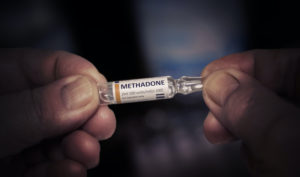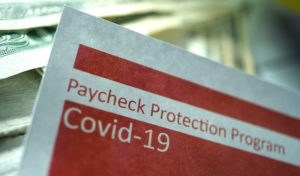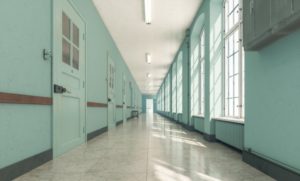
A regulatory remedy can help reduce the federal prison population during the pandemic.
Jails and prisons remain “hotspots” for COVID-19 over a year after the virus first appeared in the United States.
The federal government imprisons approximately 140,000 people across the country—and since March of 2020, over 46,000 of those in custody of the Federal Bureau of Prisons have tested positive for COVID-19 while serving their sentences.
Although many federally incarcerated people have received the COVID-19 vaccine, the conditions of confinement at federal prison facilities continue to facilitate the virus’s spread. These conditions include small, cramped living spaces and incarcerated people’s limited access to sanitation and personal protective equipment. Social distancing is nearly impossible, especially given the preexisting overcrowding of prison facilities.
In light of these conditions, the U.S. Department of Justice has directed the Bureau of Prisons to expand the program designed to move people out of federal prisons: home confinement. Home confinement, also referred to as home detention or house arrest, is a program that allows incarcerated people to spend the last portion of their sentences in their homes rather than in prison.
Since the outbreak of the pandemic, the Bureau has placed over 23,000 people in home confinement—many of whom have since completed their sentences. Given the continued threat that COVID-19 poses to incarcerated people, however, home confinement remains an important option for sick and vulnerable people seeking to leave prison. The program also serves as a tool for the Bureau of Prisons in its ongoing effort to reduce crowding in federal prison facilities.
Home confinement is one of several community-based corrections programs that the Bureau of Prisons operates, and these programs are alternatives to incarceration designed to help reintegrate people back into their communities after their release. Although they are at home and not in federal prisons, people living in home confinement are not officially released from Bureau custody. Rather, individuals in home confinement are still subject to extensive surveillance and monitoring, meaning that their freedom is still restricted.
Whether people can be placed in home confinement is governed by a complex combination of federal statutes, regulations, and internal Bureau of Prisons policies.
Under federal statutory law, the U.S. Congress has authorized the Bureau to place incarcerated people in home confinement. Congress has further directed the Bureau of Prisons to prioritize home confinement to the extent practicable, especially for people deemed to be low risk. The Bureau has interpreted this mandate to refer to “inmates that have lower risks of reoffending in the community.”
Prior to the pandemic, Congress had authorized the Bureau of Prisons to place people in home confinement for either the last six months of their sentence or the last ten percent of their term of imprisonment, whichever was less. A narrow exception to this rule exists under the Second Chance Act, which allows the Bureau to waive the six-month or ten-percent-of-sentence requirement for elderly or terminally ill people, who can be placed in home confinement for longer periods of time.
But recognizing the impact that COVID-19 could have among the prison population, Congress also expanded the Bureau’s home confinement authority last year when it passed the Coronavirus Aid, Relief, and Economic Security Act, better known as the CARES Act.
The CARES Act provides that if the Attorney General finds that emergency conditions will “materially affect the functioning” of the Bureau of Prisons, the Bureau Director may lengthen the maximum amount of time for which the Bureau is authorized to place someone in home confinement.
Former Attorney General William Barr officially made this finding last April when he issued a memorandum directing the Bureau to prioritize home confinement at institutions most affected by COVID-19. As a result, the Bureau is authorized “to maximize the amount of time spent on home confinement.” With its authority expanded under the CARES Act, the Bureau can now grant home confinement to inmates who have, for example, served less than 90 percent of their sentence or have more time left to serve than just six months.
Just five days before President Trump left office, the Justice Department’s Office of Legal Counsel issued a memorandum stating that under the CARES Act and previously existing federal law, the Bureau’s authority to keep people on home confinement for long periods of time would “evaporate” at the conclusion of the national emergency. Functionally, the Office of Legal Counsel’s interpretation means that when the pandemic subsides, the Bureau of Prisons would have to “recall” people who are currently in home confinement back into federal prisons.
Given the continued prevalence of COVID-19 and the slow vaccine rollout, it appears that the national emergency is far from over—so incarcerated people are still able to qualify for and be placed on home confinement. But as the guidance from Attorney General Barr made clear, not every person in federal prison will be released.
Who exactly is eligible for this program? In light of the COVID-19 pandemic, Justice Department guidance instructs the Bureau of Prisons to consider the “totality of the circumstances” for each individual when determining whether to place that person in home confinement. The Bureau can consider a number of discretionary factors, including individuals’ vulnerability to COVID-19, their underlying health conditions, and whether they would have better access to medical treatment in prison than at home. The Bureau can also consider personal risk factors, including an individual’s crime of conviction and the viability of that person’s re-entry plan.
Internal policies at the Bureau of Prisons also require that when a person is referred for community correction programming, the Bureau must consider that person’s employment prospects and any needs for specialized treatment, such as substance abuse programming.
Even with these statutory factors and Justice Department guidance, whether incarcerated people are placed on home confinement is a determination left to the Bureau’s “considerable discretion.” Federal law provides that the Bureau of Prisons has the ultimate authority when it comes to making determinations about where people convicted of federal crimes serve their sentences. For example, even if a sentencing court ordered that a person serve some amount of time in home confinement, that order “shall have no binding effect” on the Bureau’s authority “to determine or change the place of imprisonment of that person.”
The Bureau’s policies further specify that only the Bureau may approve someone’s placement in home confinement, and federal law insulates the Bureau’s determinations about home confinement from judicial review. Although incarcerated people denied home confinement cannot seek judicial intervention, they can ask the Bureau to reconsider their cases.
The number of incarcerated people testing positive for COVID-19 continues to grow, even while the Bureau of Prisons has administered over 100,000 vaccines to incarcerated people and suspended visiting at many of its facilities.
About 7,500 people on home confinement are still serving federal prison time. As the pandemic continues to spread among prison populations, the Bureau may continue using its emergency authority to place people on more extensive periods of home confinement.



